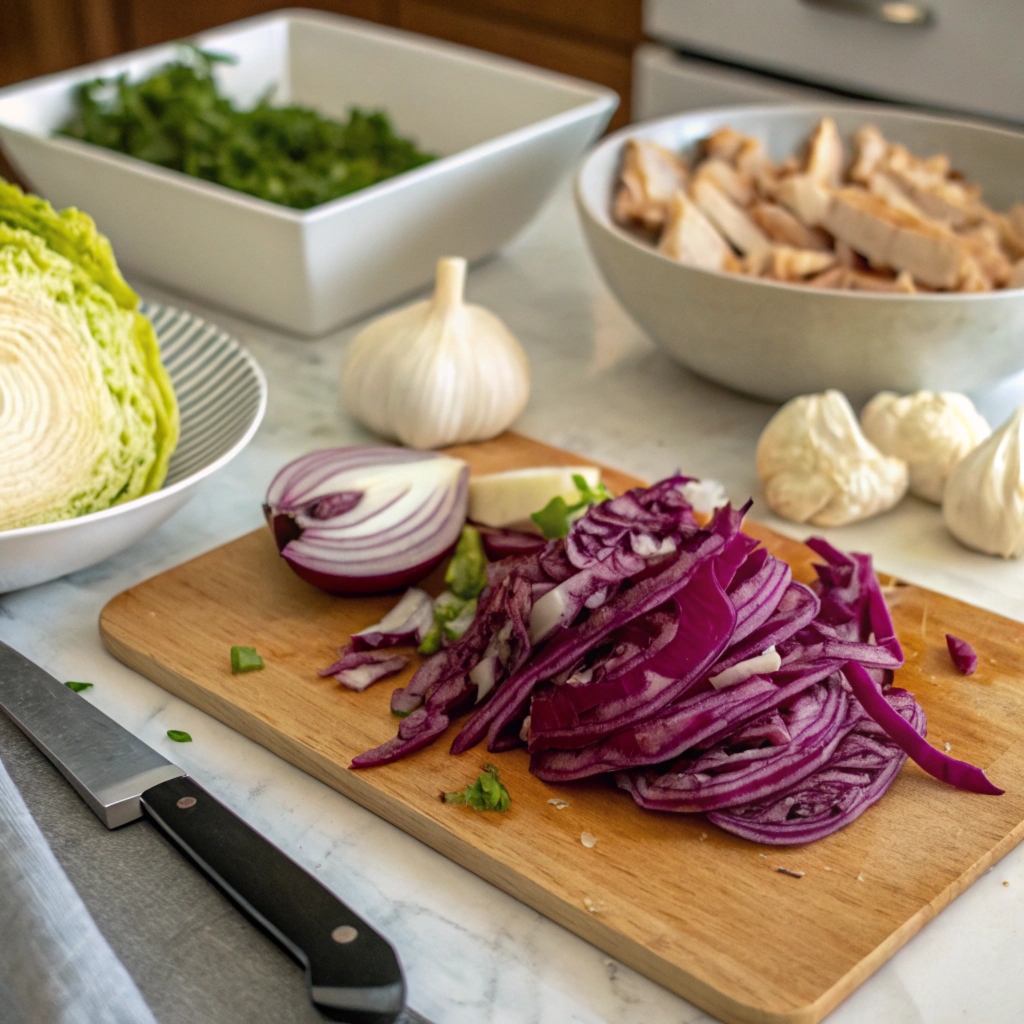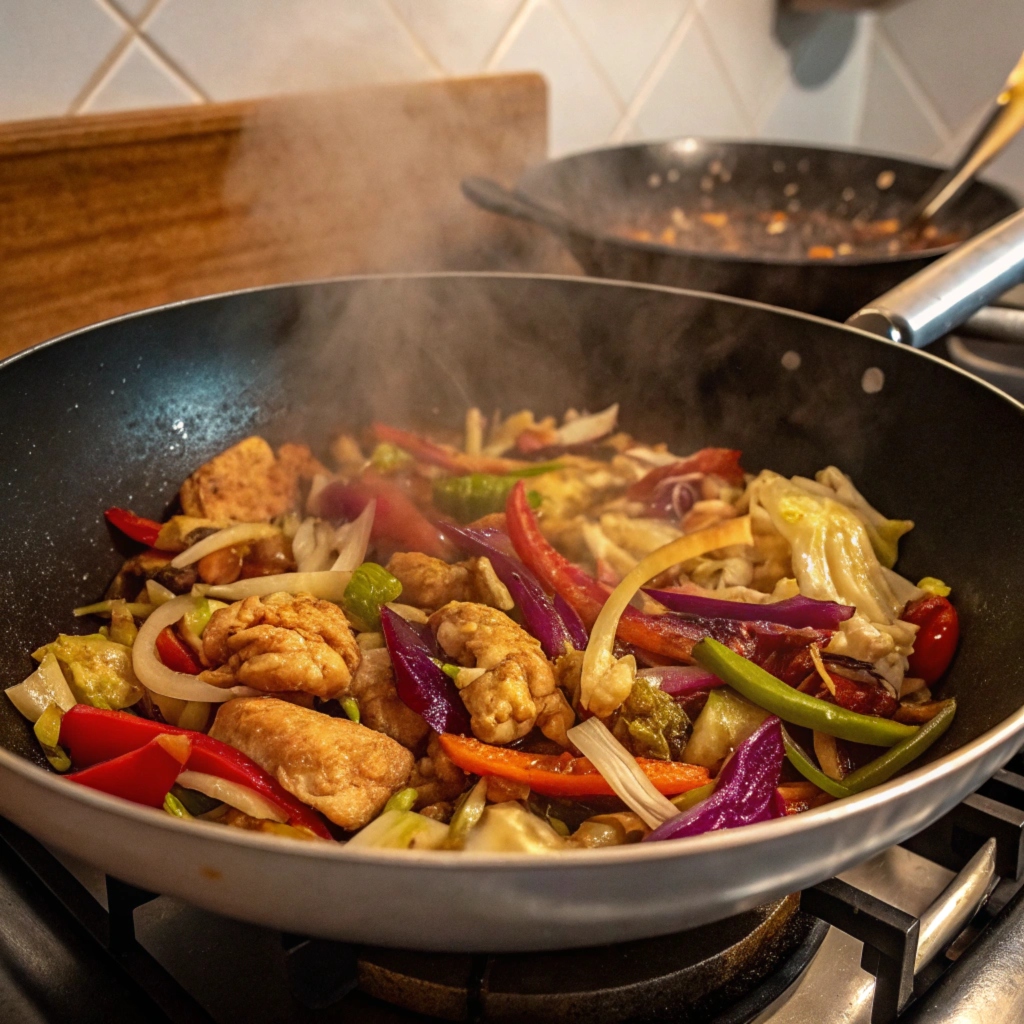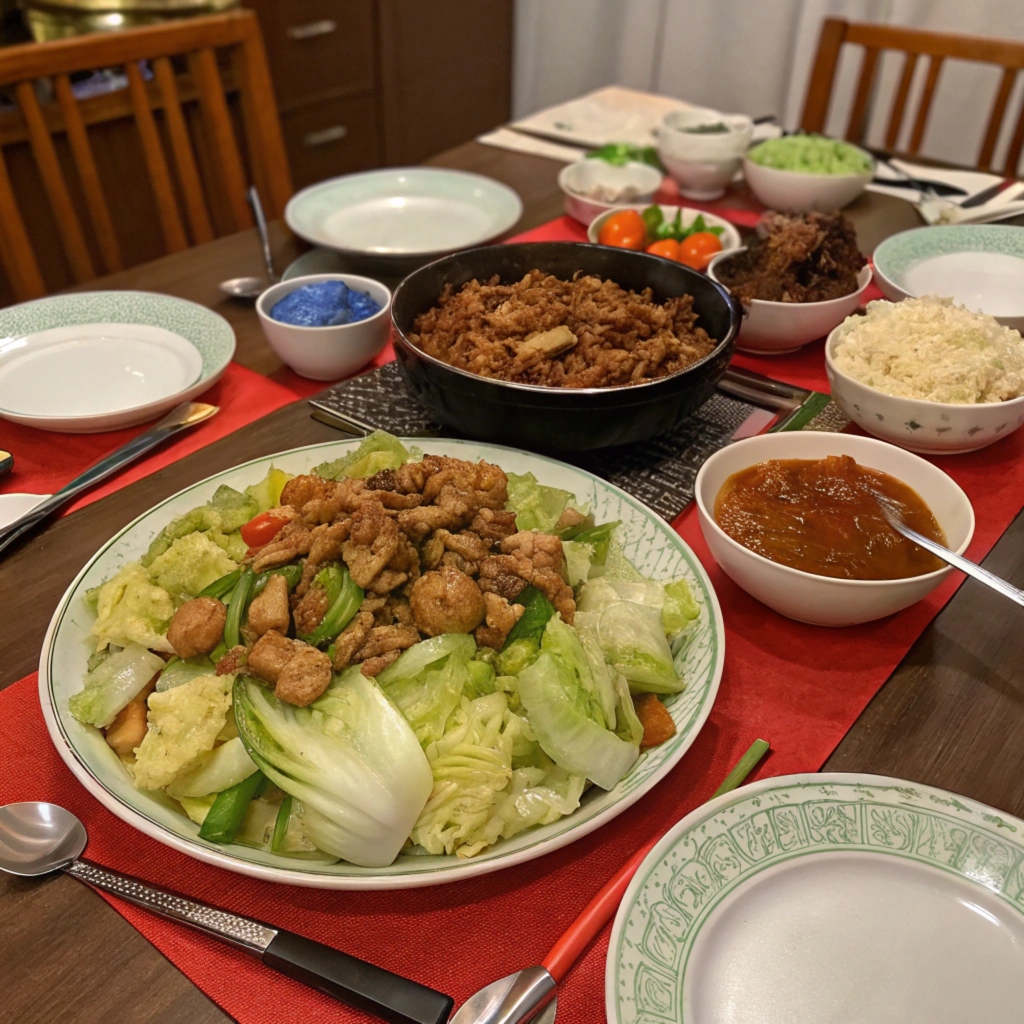Hmong cabbage and chicken recipe is a hidden gem in the culinary world, offering a unique blend of flavors, textures, and cultural heritage. Rooted in simplicity and sustainability, Hmong dishes are designed to bring people together, often served family-style with plenty of fresh ingredients. Among the many delightful dishes in Hmong cooking, the cabbage and chicken recipe stands out for its perfect balance of flavor, nutrition, and comfort.
Why is this dish so special? It’s more than just a meal—it’s a story on a plate. From its vibrant colors to the aromatic blend of garlic, ginger, and soy sauce, this dish embodies the heart of Hmong traditions. You’ll find it equally suitable for a busy weeknight dinner or a festive family gathering.
Table of contents
The Cultural Significance of Cabbage and Chicken in Hmong Recipes
In Hmong culture, food is more than sustenance; it’s a connection to history and family. Cabbage and chicken are staples in Hmong households due to their accessibility and versatility. Cabbage, a hardy vegetable, symbolizes nourishment and longevity. Chicken, often prepared fresh, represents abundance and celebration. Together, these ingredients create a dish that feels both familiar and festive.
Hmong cabbage and chicken recipe is often prepared for special occasions, served as part of a larger feast, or enjoyed simply with a side of warm rice. It’s a dish that bridges generations, allowing elders to pass down traditional cooking techniques while younger family members savor the flavors of their heritage.
Why You’ll Love This Recipe
So, why should you try this recipe? Let’s break it down:
- Simple Ingredients, Big Flavors
The recipe uses everyday ingredients like cabbage, chicken, garlic, and soy sauce, yet the result is anything but ordinary. Each bite bursts with flavor. - Quick and Easy
In less than an hour, you can create a dish that feels like it took hours to perfect. It’s ideal for home cooks who want to impress without stress. - Healthy and Nutritious
Packed with lean protein from the chicken and vitamins from the cabbage, this dish is as healthy as it is tasty. No guilt here—just good food! - Customizable
Whether you like it spicy or prefer a milder flavor, this recipe can easily adapt to your taste preferences.
Key Flavors and Ingredients
The beauty of Hmong cabbage and chicken lies in its simplicity. Here’s a breakdown of the key ingredients:
- Cabbage: A mildly sweet, crunchy vegetable that soaks up the sauce beautifully. Green cabbage works best, but Napa cabbage is a great alternative.
- Chicken: Boneless, skinless chicken thighs or breasts are ideal for tender, juicy results.
- Garlic and Ginger: These aromatics form the backbone of the dish, delivering warmth and depth.
- Soy Sauce and Fish Sauce: These two sauces provide the umami punch that makes this recipe irresistible.
- Fresh Herbs: Cilantro or green onions are used for garnish, adding a pop of freshness and color.
Health Benefits of Cabbage and Chicken
Aside from being delicious, this recipe is packed with nutrients:
- Cabbage is a powerhouse of vitamins C and K, known for their immune-boosting and bone-strengthening properties. Its fiber content aids digestion and keeps you feeling full longer.
- Chicken is an excellent source of lean protein, essential for muscle growth and repair. It also contains B vitamins, which support energy production.
- Garlic and Ginger not only enhance the flavor but also have anti-inflammatory and immune-boosting benefits.
This combination makes Hmong cabbage and chicken recipe a wholesome meal that nourishes your body and soul.
Preparing for the Recipe
Before you dive in, let’s ensure you’re well-prepared. Cooking is so much more enjoyable when you have everything ready to go!
Essential Ingredients
Here’s what you’ll need to get started:
- 1 medium green cabbage, thinly sliced
- 1 lb chicken thighs or breasts, cut into bite-sized pieces
- 3 cloves garlic, minced
- 1 tablespoon fresh ginger, grated
- 3 tablespoons soy sauce
- 1 tablespoon fish sauce
- 1 teaspoon sugar (optional, for a touch of sweetness)
- 2 tablespoons vegetable oil
- ½ cup chicken broth or water
- Salt and pepper to taste
- Fresh cilantro or green onions for garnish

Tools and Equipment Needed
Make sure you have the following:
- A sharp knife and cutting board for slicing cabbage and chicken.
- A large wok or skillet for cooking everything evenly.
- Measuring spoons for accurate seasoning.
- A wooden spoon or spatula for stirring.
“Cooking is not about fancy equipment; it’s about creating magic with what you have.”
Step-by-Step Recipe Instructions
Preparing the Ingredients
Before you start cooking, it’s essential to get all your ingredients prepped and ready. This step makes the cooking process smooth and enjoyable. Think of it as setting the stage for a delicious masterpiece.
- Slice the Cabbage:
Use a sharp knife to cut the cabbage into thin strips. If you prefer a chunkier texture, you can cut it into larger pieces, but thin slices cook faster and absorb flavors more effectively. - Cut the Chicken:
Dice the chicken thighs or breasts into bite-sized pieces. Uniform sizes ensure even cooking. Pat them dry with a paper towel to help them brown nicely. - Mince the Garlic and Grate the Ginger:
Fresh garlic and ginger are non-negotiable for this recipe. The aromas they release when cooking will transform your kitchen into a fragrant haven. - Prepare the Sauces:
In a small bowl, mix the soy sauce, fish sauce, and optional sugar. This combination will be the flavor foundation of your dish. - Gather Garnishes:
Chop fresh cilantro or green onions for garnish. This step is optional but adds a lovely pop of color and freshness to the final dish.
Cooking the Chicken
Now that your ingredients are prepped, it’s time to fire up the stove. Here’s how to get perfectly cooked chicken every time:
- Heat the Wok or Skillet:
Add 1 tablespoon of vegetable oil to your wok or skillet and heat it over medium-high heat. You’ll know it’s ready when the oil starts to shimmer. - Cook the Chicken:
Add the chicken pieces in a single layer. Avoid overcrowding the pan; if necessary, cook the chicken in batches. Let the pieces sear for 2-3 minutes without stirring to develop a golden crust. - Flip and Cook Through:
Stir the chicken to cook it evenly, about another 3-4 minutes. Once the chicken is no longer pink in the center, transfer it to a plate and set it aside.
“The secret to juicy chicken? High heat and patience. Let it brown undisturbed for that perfect sear.”

Adding the Cabbage and Seasoning
With the chicken cooked, it’s time to focus on the cabbage and bring everything together:
- Sauté the Aromatics:
In the same wok or skillet, add the remaining tablespoon of oil. Toss in the minced garlic and grated ginger. Stir for 30 seconds to a minute, just until fragrant. - Add the Cabbage:
Toss the sliced cabbage into the pan. Stir continuously to coat the cabbage with the aromatic oil. Cook for about 3-4 minutes until it starts to soften. - Deglaze the Pan:
Pour in the chicken broth or water. This step lifts all those delicious browned bits from the bottom of the pan, adding depth to your dish. - Season the Cabbage:
Add the soy sauce mixture to the cabbage, stirring to combine. Taste and adjust with salt and pepper if needed.
Final Touches for Perfection
Now comes the exciting part: combining all the elements and finishing the dish.
- Reintroduce the Chicken:
Return the cooked chicken to the wok or skillet. Stir to mix it with the cabbage and allow the flavors to meld together. - Simmer for Harmony:
Reduce the heat to low and let the mixture simmer for 2-3 minutes. This ensures the cabbage absorbs all the delicious flavors while staying slightly crisp. - Garnish and Serve:
Remove the dish from heat and sprinkle it with fresh cilantro or green onions. Serve hot with a side of steamed rice for a complete meal.
“Garnishing is like putting the cherry on top—it’s the small detail that makes your dish look and taste spectacular.”
Common Problems and Solutions in Making Hmong Cabbage and Chicken Recipe
No recipe is without its challenges, but don’t worry—every problem has a solution:
- Overcooked Chicken:
If your chicken ends up dry, it’s likely overcooked. Stick to high heat for a shorter time and remove the chicken as soon as it’s no longer pink. - Soggy Cabbage:
To avoid mushy cabbage, don’t overcook it. Aim for tender-crisp by keeping a close eye on the texture as it cooks. - Too Salty:
Soy sauce and fish sauce can be quite salty. Always taste as you go and dilute with chicken broth if needed. - Lack of Flavor:
If the dish feels flat, add a squeeze of fresh lime juice or a dash of chili flakes for a kick.
Tips for Success
- Prep in Advance:
Hmong cooking is all about efficiency. Having everything ready before you start cooking ensures a seamless process. - Use Fresh Ingredients:
Fresh cabbage, garlic, and ginger make all the difference in flavor. - Don’t Skip the Garnish:
The fresh herbs add a burst of flavor and aroma that elevate the dish.
Serving Suggestions
Pairing with Rice and Side Dishes
The beauty of Hmong cabbage and chicken lies in its simplicity, but pairing it with the right sides can elevate your meal to a whole new level. Here are some ideas to round out your dish:
- Steamed Jasmine Rice
Hmong cabbage and chicken is traditionally served with a generous helping of steamed jasmine rice. The rice’s delicate aroma and slightly sticky texture are the perfect foil for the rich, savory flavors of the dish. - Sticky Rice (Khao Niew)
If you want a more authentic Hmong experience, try serving this dish with sticky rice. Sticky rice is a staple in Hmong cuisine and is ideal for scooping up every last bite of chicken and cabbage. - Fresh Vegetable Side Dishes
Consider pairing the dish with a side of fresh cucumber slices or a light vegetable salad. These add a refreshing crunch that balances the richness of the main dish. - Spicy Dipping Sauce
A small bowl of spicy dipping sauce (a mix of crushed chili, lime juice, fish sauce, and a pinch of sugar) adds an exciting kick for those who like their meals extra bold.
Beverage Options
Choosing the right drink can complement the flavors of the dish beautifully. Here are some beverage ideas:
- Traditional Tea: Serve the meal with a cup of green tea or jasmine tea for a calming and aromatic pairing.
- Iced Lemon Water: The citrusy freshness helps cleanse the palate between bites.
- Light Beer: If you prefer an alcoholic beverage, a light beer can pair wonderfully with the dish’s umami and savory notes.
“The secret to a memorable meal isn’t just the food—it’s the whole experience, from the sides to the drinks and the company you share it with.”

Enhancing Your Meal: More Ideas
- Easy Pastalaya Recipe: A fusion of pasta and jambalaya that adds a hearty and spicy twist to your table.
- Quick Fixes for Dry Leftover Chicken: Transform any leftover chicken into a delectable meal.
- Secrets to Making the Best Rotisserie Chicken Pasta: Perfect for repurposing your chicken into a creamy, comforting dish.
- What to Do with Overcooked Chicken Thighs: Learn how to save overcooked chicken and still create a delightful recipe.
Frequently Asked Questions (FAQs)
Can I Substitute Ingredients?
Yes, absolutely! One of the best things about this recipe is its versatility:
- If you don’t have chicken, try using turkey or tofu for a vegetarian option.
- Napa cabbage or bok choy can replace green cabbage for a different texture.
- Soy sauce alternatives like tamari or coconut aminos work well if you’re avoiding gluten.
How Do I Store Leftovers?
Leftovers can be stored in an airtight container in the refrigerator for up to three days. Reheat gently on the stove or in the microwave to preserve the flavors.
Can I Make It Spicy?
Yes! Add chili flakes or sliced fresh chilies during the cooking process for an extra kick. Alternatively, serve with a side of chili sauce for customizable heat.
e leftover chicken, reducing food waste and delighting your taste buds.
Conclusion and Final Thoughts
Hmong cabbage and chicken recipe is more than just a dish—it’s a celebration of tradition, simplicity, and the joy of sharing a meal with loved ones. With its tender chicken, crunchy cabbage, and perfectly balanced seasoning, it’s a recipe that anyone can master and enjoy.
Whether you’re new to Hmong cabbage and chicken recipe or looking to expand your culinary repertoire, this recipe is a fantastic place to start. Its versatility, ease of preparation, and bold flavors make it a surefire crowd-pleaser.
So, why wait? Gather your ingredients, fire up the stove, and let the aromas of garlic, ginger, and soy sauce fill your kitchen. This dish will quickly become a staple in your home, cherished by everyone who tastes it.
“Every dish tells a story. With Hmong cabbage and chicken, the story is one of love, tradition, and the simple pleasures of home cooking.”
